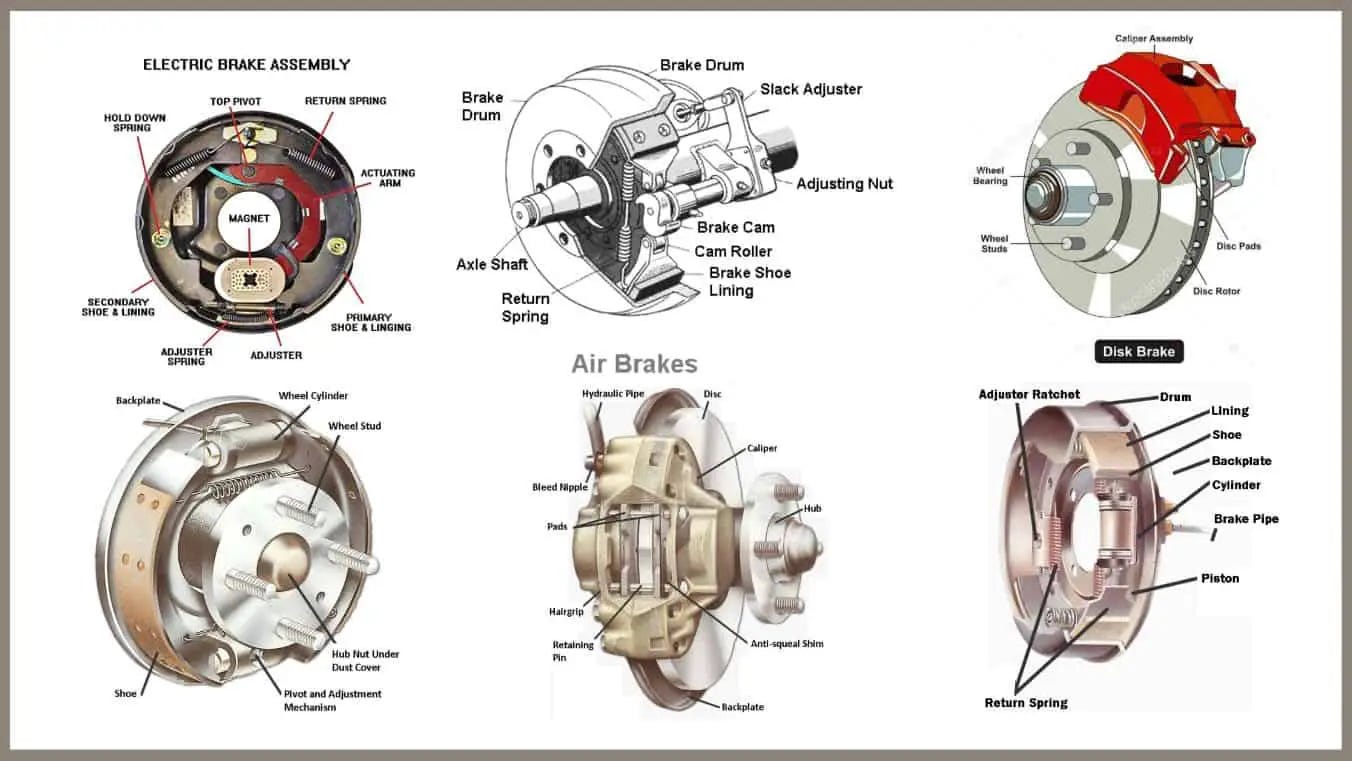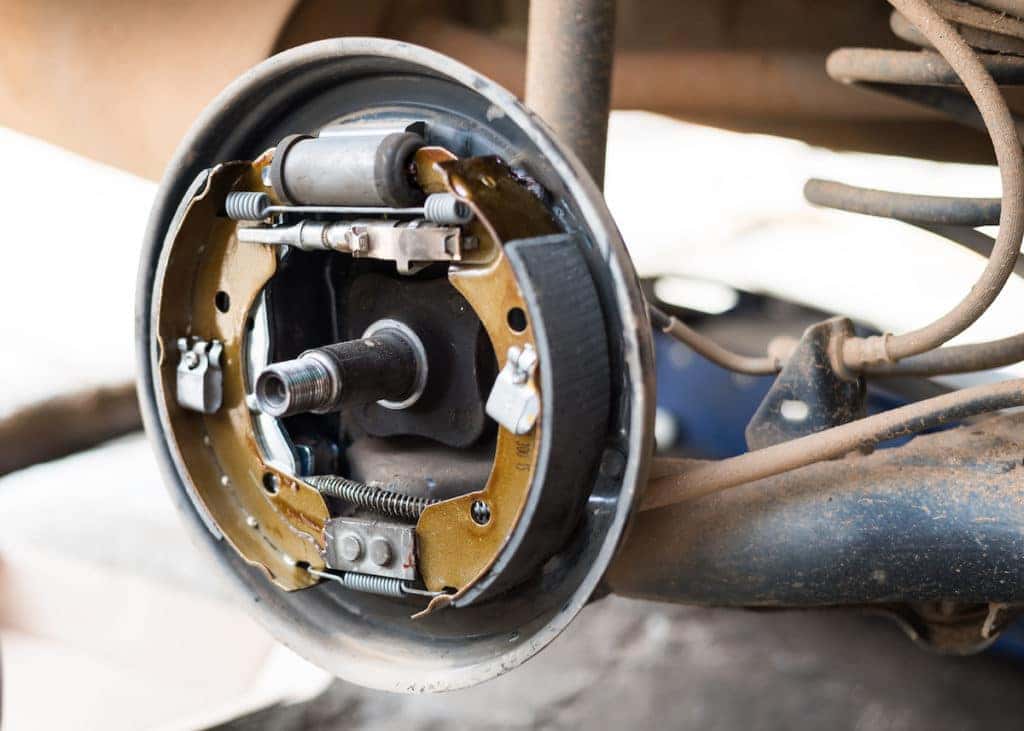There are several types of brakes, including disc brakes, drum brakes, anti-lock braking systems (ABS), and regenerative brakes, each serving different purposes. Disc brakes offer better performance and heat dissipation, while drum brakes are more cost-effective and durable. ABS enhances safety by preventing wheel lock-up during hard braking, and regenerative brakes in electric vehicles help recover energy during braking.
When it comes to vehicle safety and performance, the type of brakes used is crucial. Understanding the different types of brakes and their functions can help you make informed decisions about your vehicle’s maintenance and upgrades. We will explore the four main types of brakes, their features, and their advantages and disadvantages.
Whether you’re a car enthusiast or simply want to know more about how your vehicle operates, this guide will provide valuable insights into the world of braking systems.

Contents
Types of Brakes
There are several types of brakes, including –
1. Disc Brakes
Disc brakes are one of the most common and widely used brake systems in modern vehicles, especially in passenger cars, motorcycles, and high-performance vehicles. They work by using a brake caliper to squeeze pairs of brake pads against a spinning brake rotor (disc), creating friction to slow or stop the vehicle.
Components of Disc Brakes:
- Brake Rotors (Discs): Circular discs attached to the wheels.
- Brake Pads: Friction material that presses against the rotor.
- Caliper: Houses the brake pads and hydraulically presses them onto the rotor.
How Disc Brakes Work:
When the brake pedal is pressed, hydraulic fluid forces the brake caliper to push the pads against the rotors. The resulting friction slows down or stops the rotation of the wheels.
Advantages of Disc Brakes:
- Better Cooling: Disc brakes have better heat dissipation, making them less prone to overheating.
- Superior Stopping Power: They provide better braking performance, especially in high-speed or emergency situations.
- Self-Cleaning: The open design of disc brakes helps them remain cleaner, as debris is thrown off during rotation.
Disadvantages of Disc Brakes:
- Cost: Disc brakes are generally more expensive than other brake types.
- Wear and Tear: Brake pads wear out over time and need regular replacement.
Applications:
Disc brakes are commonly found in most modern cars, motorcycles, and bicycles, particularly on the front wheels where more stopping power is needed.
2. Drum Brakes
Drum brakes were once the standard braking system in most vehicles but have gradually been replaced by disc brakes due to their performance advantages. However, drum brakes are still used in some vehicles, especially for the rear wheels, where less braking force is required.
Components of Drum Brakes:
- Brake Drum: A cylindrical drum that rotates with the wheel.
- Brake Shoes: Curved pieces of friction material that press against the inside of the drum.
- Wheel Cylinder: Contains pistons that push the shoes against the drum when the brakes are applied.
How Drum Brakes Work:
When the brake pedal is pressed, hydraulic pressure forces the wheel cylinder’s pistons to push the brake shoes outward, pressing them against the inside of the drum. The resulting friction slows down or stops the wheel’s rotation.
Advantages of Drum Brakes:
- Durability: Drum brakes last longer and are less susceptible to external damage due to their enclosed design.
- Low Cost: They are typically cheaper to manufacture and maintain than disc brakes.
- Parking Brake Integration: Many vehicles use drum brakes for the rear because they easily integrate with a parking brake system.
Disadvantages of Drum Brakes:
- Poor Heat Dissipation: Drum brakes tend to overheat more easily than disc brakes, leading to brake fade.
- Less Responsive: They can be less effective in high-speed or heavy braking situations.
Applications:
Drum brakes are still found in some economy cars, trucks, and trailers, particularly on the rear wheels.
3. Anti-lock Braking System (ABS)
The Anti-lock Braking System (ABS) is an advanced braking technology designed to prevent wheel lock-up during emergency braking or on slippery surfaces. By keeping the wheels rotating, ABS allows the driver to maintain control and steer the vehicle, which can prevent skidding and reduce stopping distances.
How ABS Works:
ABS uses sensors to monitor the speed of each wheel. If the system detects a wheel is about to lock up, it rapidly pulses the brakes, reducing pressure on that specific wheel. This pulsing happens many times per second, preventing skidding and allowing the driver to maintain control.
Advantages of ABS:
- Enhanced Safety: Reduces the risk of skidding and helps drivers maintain steering control during hard braking.
- Improved Stopping Power: In some conditions, ABS can reduce stopping distances by preventing wheel lock-up.
- Effectiveness on Slippery Surfaces: Particularly useful on wet or icy roads where traction is low.
Disadvantages of ABS:
- Higher Cost: ABS-equipped vehicles tend to be more expensive.
- Potential for Malfunction: The system relies on sensors, which can sometimes fail or require maintenance.
Applications:
ABS is now standard in most modern cars, trucks, and motorcycles. It’s a vital safety feature in both passenger and commercial vehicles.
4. Emergency Brakes (Parking Brakes)
Emergency brakes, also known as parking brakes or handbrakes, are a secondary braking system independent of the main hydraulic brakes. They are used to keep the vehicle stationary, particularly when parked on an incline, or as a backup in case of main brake failure.
How Emergency Brakes Work:
Emergency brakes are typically mechanical systems that operate through cables connected to the rear brakes. Pulling the handbrake lever or pressing the foot-operated emergency brake applies tension to the cables, which engage the rear brakes.
Types of Emergency Brakes:
- Hand-Operated Lever: Common in many vehicles, especially older models, where the lever is located between the front seats.
- Foot-Operated Pedal: Found in many trucks and some cars, this type of emergency brake is operated by pressing a pedal near the driver’s feet.
- Electronic Parking Brake (EPB): A modern version that uses a button to engage the parking brake instead of a mechanical lever.
Advantages of Emergency Brakes:
- Parking Stability: Ensures the vehicle doesn’t roll when parked, especially on steep inclines.
- Backup Safety: Can be used as a last resort if the main braking system fails.
Disadvantages of Emergency Brakes:
- Limited Stopping Power: Not designed for stopping a moving vehicle; it’s mainly for holding a parked vehicle in place.
- Maintenance: Cables can stretch or wear out over time, requiring adjustment or replacement.
Applications:
Every vehicle, from small cars to heavy trucks, comes with an emergency brake system. While used primarily for parking, it can also serve as a backup in an emergency situation.
5. Regenerative Brakes (Used in Electric and Hybrid Vehicles)
Regenerative braking is a feature found in electric and hybrid vehicles. It’s an energy recovery mechanism that captures some of the vehicle’s kinetic energy during braking and converts it into electricity to recharge the vehicle’s battery.
How Regenerative Brakes Work:
In an electric vehicle, when the driver presses the brake pedal, the electric motor reverses its function, acting as a generator. This process slows the vehicle down while converting kinetic energy into electrical energy, which is then stored in the battery.
Advantages of Regenerative Brakes:
- Energy Efficiency: Converts energy that would otherwise be lost during braking into usable electricity, improving overall efficiency.
- Reduced Wear: Since regenerative braking handles much of the braking, the wear and tear on the mechanical brakes are reduced.
Disadvantages of Regenerative Brakes:
- Limited Stopping Power: Regenerative braking alone is not enough to bring a vehicle to a complete stop, so traditional brakes are still required.
- Complexity: The system is more complex than traditional braking systems and can be expensive to repair.
Applications:
Regenerative braking is primarily used in electric and hybrid vehicles. It is one of the key technologies that help these vehicles maximize their energy efficiency.
6. Hydraulic Brakes
Hydraulic brakes rely on brake fluid to transfer force from the brake pedal to the brake components, whether they are disc or drum brakes. This is the most common system used in modern vehicles.
How Hydraulic Brakes Work:
When the brake pedal is pressed, it pushes a piston in the master cylinder. This action forces brake fluid through brake lines to the brake calipers or wheel cylinders, which then apply pressure to the brake pads or shoes, stopping the vehicle.
Advantages of Hydraulic Brakes:
- Powerful and Efficient: Hydraulic brakes provide strong, consistent braking power.
- Widely Used: They are the most common type of brake system, making parts and maintenance readily available.
Disadvantages of Hydraulic Brakes:
- Vulnerable to Leaks: Brake fluid leaks can reduce braking performance and require immediate repair.
- Brake Fluid Maintenance: The fluid must be changed regularly to prevent contamination and maintain optimal performance.
Applications:
Hydraulic brakes are used in virtually every type of vehicle, from cars to motorcycles and trucks.

Frequently Asked Questions
Here are some FAQs about the types of brakes –
1. What is the difference between disc brakes and drum brakes?
Disc brakes use brake pads to press against a rotating disc (rotor), while drum brakes use brake shoes that press outward against a spinning drum. Disc brakes provide better heat dissipation and performance, while drum brakes are more cost-effective and durable.
2. How does ABS improve braking safety?
ABS prevents wheel lock-up during hard braking by pulsing the brakes automatically. This allows the driver to maintain steering control, especially on slippery surfaces, reducing the risk of skidding.
3. Can regenerative braking replace traditional brakes in electric vehicles?
No, regenerative braking alone cannot bring a vehicle to a complete stop. Traditional hydraulic or mechanical brakes are still necessary for full braking power.
4. How often should brakes be maintained?
Brake pads should typically be checked every 12,000 miles, while brake fluid should be changed every 2-3 years. Maintenance intervals may vary depending on driving conditions and vehicle type.
5. Why do rear wheels often use drum brakes instead of disc brakes?
Rear wheels are subject to less braking force, and drum brakes are more cost-effective. They also integrate well with parking brakes, making them a practical choice for rear-wheel braking systems in many vehicles.

Credit: www.toyotaoforlando.com
Conclusion
Knowing the different types of brake systems is essential for making informed decisions about vehicle maintenance, safety, and performance. From disc and drum brakes to advanced systems like ABS and regenerative braking, each type has its own set of benefits and applications.
As technology continues to evolve, we can expect even more advancements in brake systems in the future. Stay informed and stay safe on the road!